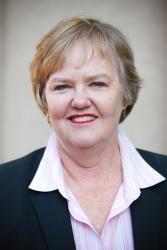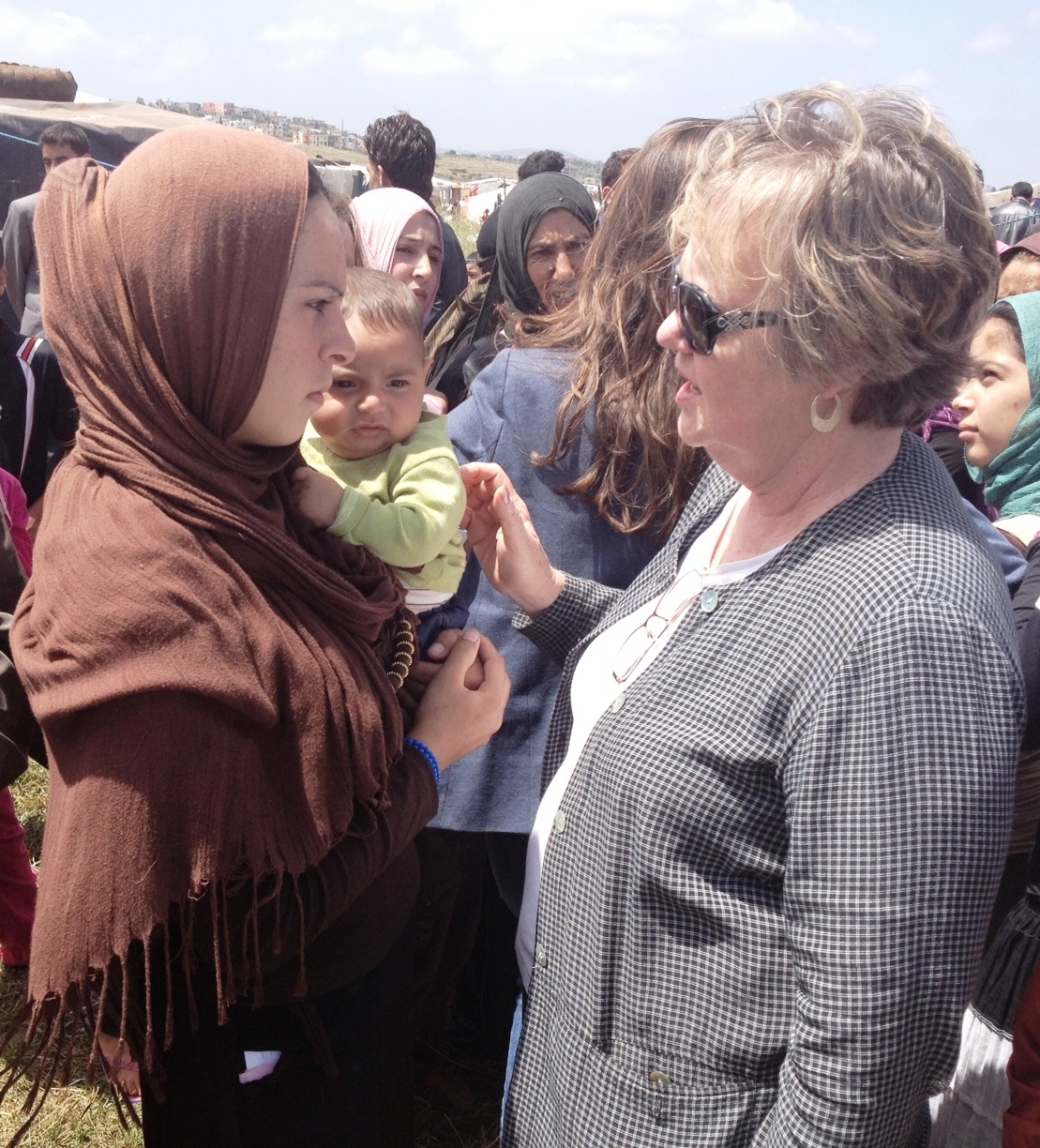I recently spent 10 days in June traveling through Jordan and Lebanon with representatives of UNHCR and the US Commission on International Religious Freedom to witness firsthand the situation of Syrian refugees and to learn whatever I could from the refugees themselves about internally displaced persons (IDPs) inside Syria. During the course of our trip, we talked with some 80 UN, NGO, government and civil society representatives and met with nearly 20 refugee families in the two countries. We visited refugees living in rented apartments (including a six-story walk-up), in a focus group at Za’atari refugee camp, and in the dusty fields around informal settlements. Everywhere children swarmed around us, reminding us that half of the Syrian refugee population is made up of kids. We traveled in SUVs with UNHCR drivers; while we didn’t feel that we were in danger, particularly in Lebanon (and especially in Tripoli and the Bekaa Valley) we were conscious of security restrictions. These are some of my impressions from the trip.
Internal displacement
Because my work focuses on IDPs, and since travel to Syria seemed impossible, I asked everyone we encountered what they knew or had heard about people displaced back in Syria. The official estimates are that there are more than 5 million Syrians who have been displaced from their homes but remain within Syria.
Everyone agreed that internal displacement was widespread and dynamic. Around half of the 20 refugee families we spoke with said that they had been displaced internally at least twice before making the move to cross a border. The other half lived within a day’s travel of the border and had come directly from their homes (usually because of a dramatic triggering event such as bombardment or release of a family member from detention.) We were told that those arriving as refugees were from the areas nearest the borders of Lebanon and Jordan; people displaced in the eastern part of the country simply weren’t able to travel to a border.
A Jordanian government representative stated that Jordan “was the fourth stop for Syrians. Syrian refugees had been displaced an average of 3 times internally before making it to Jordan.” He also pointed out that there were 250,000 IDPs in Southern Syria within 30 kilometers (less than 20 miles) of the Jordanian border and advocated for cross-border operations to assist them so that they wouldn’t try to cross into Jordan. He said that there were some 6 million Syrians living within 100 kilometers of the Jordanian border (including Damascus).
‘The battle for Damascus has not yet begun’ was a refrain repeated by many. When asked what was the ‘best-case scenario’ every person replied, ‘the status quo.’
The Jordanian government representative – and every single person we talked with – felt that the situation was going to get much worse. ‘The battle for Damascus has not yet begun’ was a refrain repeated by many. When asked what was the ‘best-case scenario’ every person replied, ‘the status quo.’
We heard numerous stories of people unable to leave Syria; some were displaced in areas where the roads to the border were simply too dangerous (landmines, kidnappings) and others were waiting until it was safe to travel. I was struck by the many refugees who said they had displaced family members back home, waiting for a detained male relative to be released before traveling.
Additionally, we heard that many IDPs are now moving to government-controlled areas, not because they support the government, but because those areas were perceived to be safer than rebel-controlled areas (at least now after the recent Syrian government’s military gains). While recent figures indicated that there are 854 public shelters inside Syria hosting 173,626 IDPs, (4.1 percent of IDPs), we were informed that many IDPs are afraid to approach these public shelters because of the presence of Syrian military/guards out front. The lucky ones are living with relatives or renting accommodations. Most are living in abandoned buildings or have pitched tents on vacant lots.
Al-Qusair was a town of 30-40,000 which fell to government troops while we were in the region. A UN assessment team managed to travel there a couple of weeks ago and found that the town had been completely destroyed and only 10-12 civilian families remained (who had come back only to see their property and recover what they could before moving on.) Where did all of those people go, I wondered? Some crossed over as refugees, of course, but certainly not all. I wondered where they were hiding, how they were surviving.
My impression is that the Syrians who have not crossed the border (either IDPs or those that remain at home) are probably even more vulnerable than the refugees. The elderly, people with disabilities, pregnant women simply have a harder time traveling than those who are younger and healthier. But information on those who remain behind is hard to come by.
And then there are the refugees.
Those Syrians who have managed to cross over as refugees into neighboring countries face a dire situation. New arrivals in Jordan are taken to Za’atari refugee camp which is an awful place, with serious security problems. The UNHCR camp manager who met with us coughed from tear gas used to break up a protest shortly before we arrived. A guard at a school we visited was stabbed in the chest two hours after we were there – another protest. The night before our visit a group of young boys had dismantled and moved a police station. Although we didn’t see any weapons in the camp, the relationship between the camp and the nearby fighting was hard to ignore: the regularly scheduled buses taking single young men back to Syria from the camp every day, the general acceptance that Free Syrian Army soldiers on R&R in the camp needed prostitutes and in the recruitment of young men and boys into the FSA (not quite forced recruitment, as most of the boys have nothing to do in the camp and the resistance has been portrayed as glamorous.)
Education for refugee children is lacking everywhere in the region. In Za’atari there are 6000 places in schools and at least 50,000 children of school age. There is frequent vandalism, widespread looting and a brisk trade in relief items (Za’atari has a population of 120,000 but 200,000 active ration cards.) The camp manager told us, “this makes Mogadishu look like a holiday.” He explained that at least in Mogadishu there was a safe haven in the compound, but in Za’atari there was no place for international staff to hide if anything got out of hand: “We’d be sitting ducks in our tents and containers.” This comment has been much in my mind since the recent attack on the UN compound in Mogadishu where the staff, at least, could find a safe place when the violence erupted.
Urban refugees in Jordan (80 percent of the refugees in that country) seem to face increasing rejection, discrimination and impoverishment. When we left one refugee family’s apartment, the women said,”you’re so lucky.” We asked what they meant. ”You get to leave,” she replied, ”We haven’t left the apartment in months because we’re afraid to go out. We can tell our neighbors don’t like us.”
A recent Jordan Times poll found that 70 percent of Jordanians want the border closed.
The number of Syrians arriving in Jordan has decreased and we heard different reasons for the falling numbers. Some said the decrease was due to increased fighting on the Syrian side which made it more difficult for refugees to reach the border. Others worried that the Jordanian government is restricting the entry of refugees. Arrivals one month ago averaged about 3000 per night. Now they’re down to about 500 (after stopping entirely for a week in May). Even an NGO representative, obviously sympathetic to the refugees, said “if I were the Jordanian government, I’d close the border today. This is just unsustainable.” We heard stories (perhaps hearsay, but repeated nonetheless) of Jordanians who couldn’t get medicine from a pharmacy or whose elderly relatives couldn’t get necessary operations because the hospitals were crowded with refugees.
The situation in Jordan is bad, but it is sadly much worse in Lebanon. The caretaker government is weak, unable to make decisions and apparently deadlocked between Hezbollah and other factions. It is widely believed that the government does not have the capacity to control the border (which is perhaps why the Lebanese border remains open to Syrians.)
Sectarian conflict within Lebanon is increasing; there are armed skirmishes almost daily in Tripoli and the border regions. The entry of 550,000 Sunni Muslims (in addition to the 500,000 Syrian migrant workers in the country prior to the crisis) into the country is changing the country’s demography and thus potentially the balance of power within Lebanon. Lebanon has long been divided into religious communities since its civil war, but the ubiquitous presence of the refugees is challenging these settlement patterns. Large numbers of Sunni refugees are now living in the Bekaa Valley, including in neighborhoods that are Hezbollah strongholds. The political tension in Lebanon is palpable: people are expecting the worst and feeling trapped. As one Lebanese told us over coffee, ”when Israel attacked Lebanon in 2006, hundreds of thousands fled to Syria. That’s now closed. There will be nowhere to flee if war breaks out again.”
There are no refugee camps in Lebanon so the refugees live everywhere – abandoned schools, half-finished buildings, empty lots. As in Jordan, the initial hospitality and solidarity has worn thin. In some cases refugees are able to find work in the informal sector but wages have decreased and jobs are scarce. And while there are some who have clearly benefited economically from the influx of refugees (such as landlords), many Jordanians and Lebanese have suffered from the pressure on public services and resources. The Lebanese economy has plummeted and tourism and investment are way down. We stayed in the high-rise luxury Sheraton hotel but I never saw more than 5 people at breakfast.
My feeling is that things will only get worse for the refugees and for the countries that host them. The money that refugees were able to bring with them is running out. Refugees who spent their initial savings on rent and can no longer pay are facing evictions (a phenomenon likely to increase in the coming months). Crime, we were told, has increased 30-40 percent in Lebanon; people have been caught stealing, among other things, diapers and infant formula, items not covered by the food vouchers. How do people survive without cash, I wonder? Even when they receive food vouchers, refugees still have to pay rent or else face eviction. They need money to pay bus fares or to call relatives back in Syria. If the United Nations doesn’t get the funds it needs to continue its assistance to the refugees, it will have to cut its programs and come up with ways of targeting the most vulnerable. I can’t imagine how this will play out in practice.
No one we talked with is thinking about solutions to displacement. My sense is that everyone is running at full-speed to respond to the immediate crisis. But thought must be given now to what will happen in Syria in the coming years. The war is likely to last a long time (most people we talked with predicted a duration of 10-15 years). Without exception every single refugee we spoke with said they wanted to go home as soon as possible. But even if the war were to end tomorrow, the challenges of preventing a sectarian bloodbath, physical rebuilding of decimated towns, restoring the economy, developing transitional justice mechanisms and so on will take years. It is likely to be a long time before Syrian refugees and IDPs are able to return.




